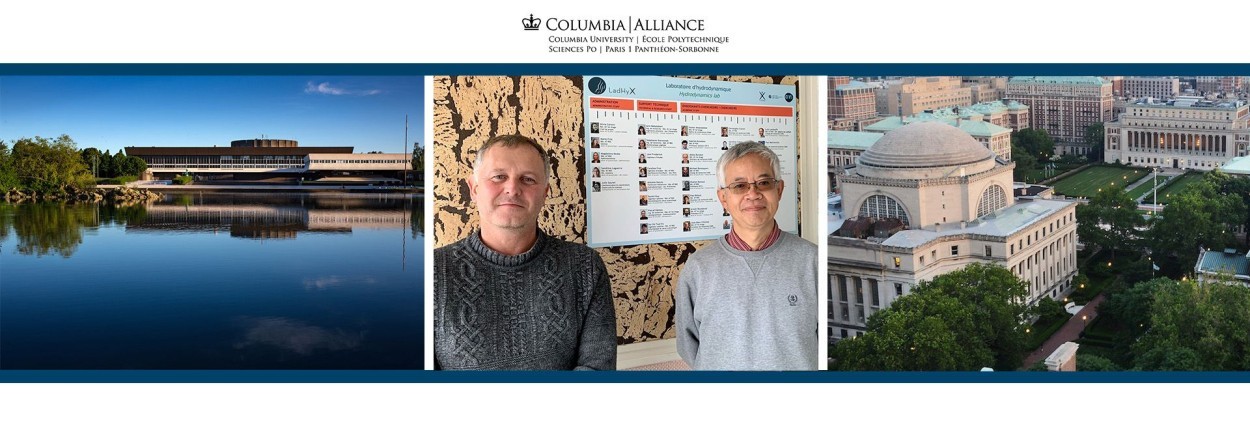VISITING PROFESSORSHIPS AT COLUMBIA UNIVERSITY AND ÉCOLE POLYTECHNIQUE
Christophe Josserand, CNRS researcher and professor at École Polytechnique, and Qiang Du, Fu Foundation Professor of Applied Mathematics at Columbia University, spent three months as visiting professors at the respective other institution in the United States and France. As they crossed paths at École Polytechnique this autumn, they agreed to tell us about their visiting professorships and experience at the partner institutions.

Invested in combining mathematics and interface modeling, Christophe Josserand, CNRS researcher and professor at École Polytechnique, and Qiang Du, professor of Applied Mathematics and member of the Data Science Institute at Columbia University, participated in Alliance’s Visiting Professorship program this year. Visiting each other at the respective partner institution for several months enabled the two scientists to pursue their discussions and further their collaboration.
Christophe Josserand, a researcher at École Polytechnique’s Hydrodynamics Laboratory (LadHyX *) focuses on the problematics of interfaces coupled with fluid mechanics. He and Qiang Du, a mathematician and computational scientist, first met at a France conference many years ago. The two scientists started to discuss modeling various physical phenomena from a mathematical perspective and have pursued their exchange over the years. “When Christophe brought up the idea of participating in the Alliance visiting Professorship program, I found it very exciting. By coming to France for some months, I knew I could also talk to other colleagues in applied math, exchange ideas, and explore possible collaborations”, comments Qiang Du.
As an applied mathematician, spending a visiting professorship at École Polytechnique, renowned for the quality of its research and academic reputation in mathematics, represented an opportunity he definitely wanted to seize. “France has such a long tradition in mathematics and applied mathematics. So many outstanding mathematicians you come across in textbooks have either worked or graduated from this institution, which makes it a tremendously inspiring place”, Qiang Du states.
Combining knowledge in Data Science and Mechanics
Beyond mathematics, Qiang Du, an affiliate faculty member of Columbia University’s Data Science Institute, is also actively interested in modeling interfaces and fluids. Contributing on the computational side, his expertise adds to Christophe Josserand’s research in this field and complements it.
Together, the two scientists examine how to combine data with fundamental principles to refine the models used in mechanics. If successful, the results would lead to new tools for researchers in applied mathematics and mechanics, using data science coupled with traditional methods. Christophe Josserand is “particularly interested in discussing whether mathematical methods, in which Qiang is an expert, could be applied to study icing or solidification problems, and more generally speaking, how to gain additional physical understanding by using data.”
Mathematics constitutes an indispensable basis for Data Science, and naturally, many research groups in mathematics conduct research in Data Science. But so far, fewer studies focus on the potential synergies of Data Science and mechanics. Christophe Josserand stresses that “it is important to examine further how Data Science can be harnessed for research in mechanics, to complement models or to make predictions by using algorithms and other techniques.”
Dive into another academic and scientific environment
“Visiting the partner institution provides the opportunity to discover its entire environment,” highlights Christophe Josserand. Starting off with the collaboration between two researchers at partner universities of the Alliance, a visiting professorship allows to delve into another academic and scientific environment, reach out to the community, and exchange with many other colleagues at the partner institution.
Given his current research focus on icing, Christophe Josserand was highly interested in connecting with the Lamont- Doherty Earth Observatory - the scientific research center of the recently founded Columbia Climate School, during his visit to Columbia earlier this year. Committed to studying the planet from its deepest interior to the outer reaches of its atmosphere, the Lamont-Doherty Earth Observatory has existed since 1949 and also operates a research ship. Lamont’s polar physics division focuses on developing an integrated ice imaging system that can measure in detail both the ice surface and the ice bed.
During his visiting professorship at Columbia University, Christophe Josserand also spent a day at Princeton University and New York University. Qiang Du seized the opportunity to visit colleagues in applied mathematics at universities around Paris.
By giving lectures and participating in colloquiums at the partner university during their visit, both scientists also brought an additional international outlook to the academic life at the partner institution. Christophe Josserand gave a lecture at Columbia University and participated in several colloquiums, as Qiang Du joined seminars of École Polytechnique’s laboratories, particularly the LadHyX, open also to other institutions within Institut Polytechnique de Paris.
Alliance Visiting Professorships
To strengthen the links between the partner institutions and to establish long-term collaborations on potential projects, Alliance provides each year up to six faculty members with the possibility to participate in transatlantic faculty exchanges. Faculty members can spend a few weeks or an entire semester as Visiting professors at the partner institution, where they will give public lectures, participate in seminars and continue to work on their research projects.
École Polytechnique, Sciences Po, and Paris 1 Panthéon-Sorbonne University each receive a faculty member of Columbia University, and one faculty member from each French partner institution can visit Columbia.
*LadHyX: a joint research unit CNRS, École Polytechnique - Institut Polytechnique de Paris
